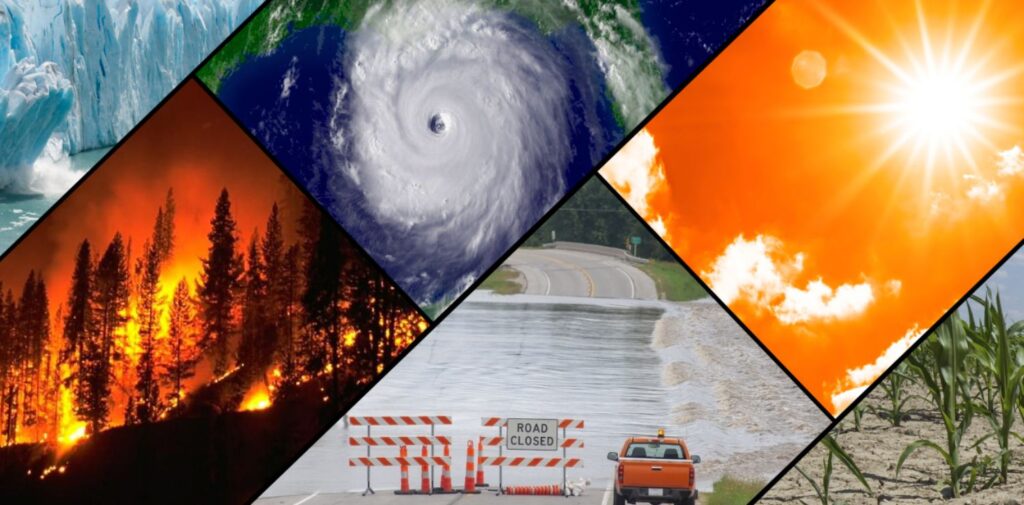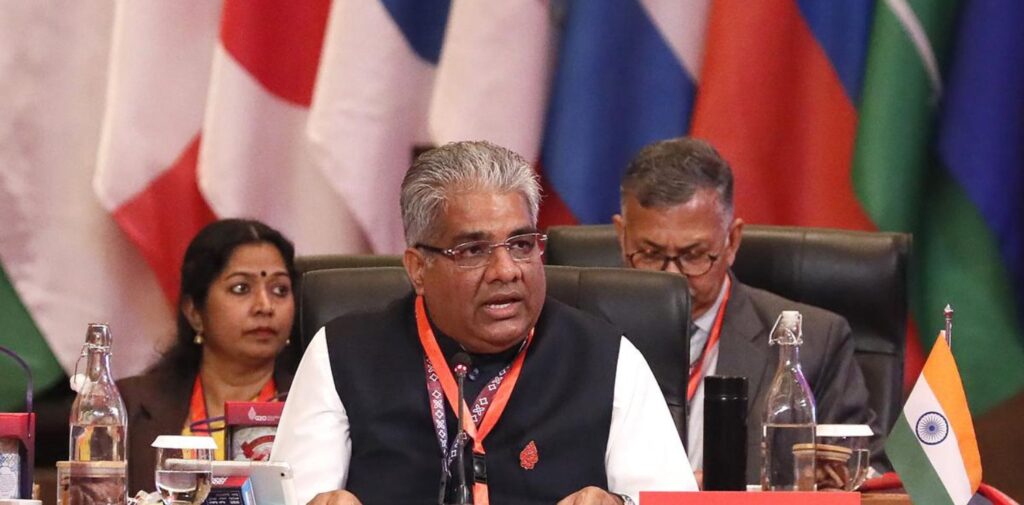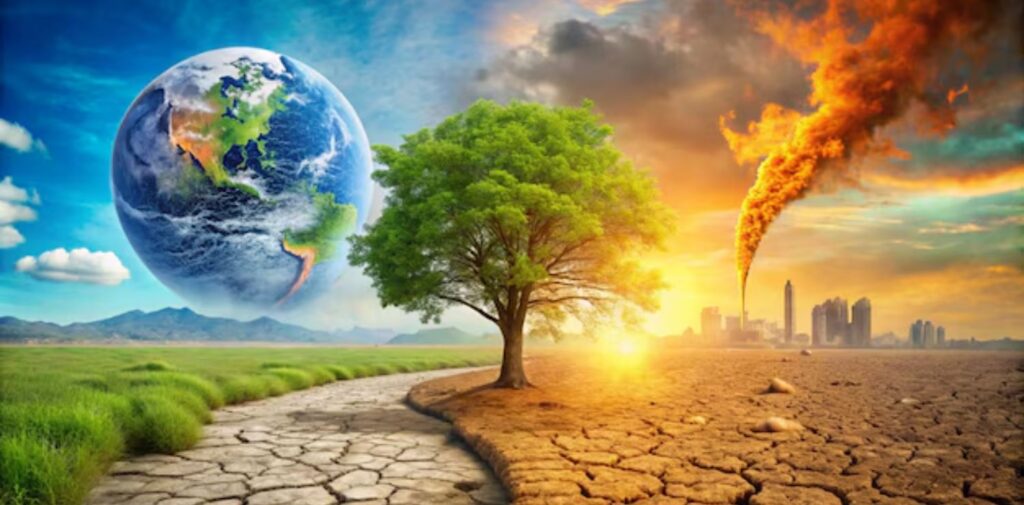Climate change is one of the most important challenges the world faces today. It is causing harm to the environment, affecting weather patterns, rising sea levels, and leading to natural disasters like floods, droughts, and storms. Climate change happens because of the release of greenhouse gases, such as carbon dioxide, into the atmosphere. These gases trap heat from the sun, causing the Earth to get warmer.
India, as one of the largest countries in the world, plays a crucial role in the fight against climate change. It is not just a big contributor to greenhouse gas emissions, but also a country that is highly vulnerable to the effects of climate change. In this article, we will look at India’s role in climate change negotiations, policies, and its efforts to reduce the impacts of climate change.

What Is Climate Change?
Before we dive into India’s role, let’s first understand what climate change is. Climate change refers to long-term changes in temperature, weather patterns, and sea levels. Over the years, human activities, especially burning fossil fuels like coal, oil, and natural gas, have been releasing large amounts of carbon dioxide (CO2) and other greenhouse gases into the atmosphere.
These gases trap the sun’s heat, causing the Earth to warm up, which results in global warming. As the Earth gets warmer, it leads to serious problems like melting glaciers, rising sea levels, and extreme weather events like heatwaves, floods, and droughts. Climate change is affecting people, animals, and the planet in many ways.
India’s Role in Climate Change Negotiations
India has an important role to play in climate change discussions on the global stage. As a developing country with a large population, India faces the challenge of growing its economy while also protecting the environment. Here are some key points about India’s role in climate change negotiations:
India’s Position in International Talks
India is one of the world’s largest economies, and its population is more than 1.4 billion people. India has historically been a major emitter of greenhouse gases due to its large-scale use of coal for energy, deforestation, and industrial growth. However, India has argued that it should not be held to the same standards as developed countries like the United States or European nations. The reason is that these developed nations have been polluting the environment for much longer and are more responsible for the current climate crisis.
India believes that developed countries should take the lead in reducing emissions, while developing countries like India should focus on improving their economies and raising living standards. India has often called for “climate justice,” which means that those who have contributed the most to climate change should help developing countries deal with its impacts.
India in the Paris Agreement
One of the biggest achievements in global climate negotiations was the Paris Agreement, which was adopted in 2015 during the United Nations Climate Change Conference (COP21) in Paris. The Paris Agreement aims to limit global warming to below 2°C, and preferably to 1.5°C, above pre-industrial levels by reducing greenhouse gas emissions.
India played an important role in the Paris Agreement by agreeing to take action on climate change, but with the condition that it should be able to grow economically and provide for its people’s needs. India promised to reduce its carbon emissions by 33-35% by 2030 compared to 2005 levels. The country also committed to generating 40% of its electricity from renewable sources, like solar and wind power, by 2030.

India’s Nationally Determined Contributions (NDCs)
India has set its own targets, known as Nationally Determined Contributions (NDCs), to help fight climate change. These targets focus on reducing carbon emissions, increasing the use of renewable energy, and improving energy efficiency. India’s NDCs include goals like:
- Reducing emissions intensity (emissions per unit of GDP) by 33-35% by 2030.
- Increasing the share of non-fossil fuels (such as solar and wind energy) to 40% of India’s total energy capacity by 2030.
- Creating a carbon market and promoting energy-efficient technologies.
India’s targets are based on the principle of “common but differentiated responsibilities.” This means that while all countries need to work towards reducing emissions, the responsibility should be shared according to the level of development of each country.
India’s Climate Change Policies
In addition to international negotiations, India has also taken steps to address climate change within the country. These policies focus on reducing greenhouse gas emissions, promoting renewable energy, and adapting to the impacts of climate change. Some of India’s key climate policies include:
National Action Plan on Climate Change (NAPCC)
The National Action Plan on Climate Change (NAPCC) was launched in 2008 to outline India’s approach to tackling climate change. The NAPCC includes eight key missions that focus on different areas, such as:
- National Solar Mission: To increase the use of solar energy in India by installing solar panels and developing solar power plants.
- National Mission on Enhanced Energy Efficiency: To improve energy efficiency in industries, buildings, and transportation.
- National Mission on Sustainable Habitat: To promote sustainable urban planning, reduce energy consumption in cities, and improve public transport.
- National Water Mission: To conserve water resources, improve water use efficiency, and protect water bodies from pollution.
- National Mission for Green India: To increase the forest cover in India and protect biodiversity.
- National Mission for Sustainable Agriculture: To promote climate-resilient farming practices and improve water management for agriculture.
- National Mission on Strategic Knowledge for Climate Change: To create a knowledge base for better decision-making on climate change.
- National Mission on Adaptation: To help India adapt to the impacts of climate change, such as droughts and floods.
These missions aim to reduce India’s vulnerability to climate change and promote sustainable development.
Renewable Energy Growth
India has set ambitious goals to increase its use of renewable energy, particularly solar and wind power. The government aims to install 175 gigawatts (GW) of renewable energy capacity by 2022, and 500 GW by 2030. As part of this effort, India has become one of the largest producers of solar energy in the world, with thousands of solar power plants being built across the country.
The government also supports the use of wind energy, hydroelectric power, and bioenergy to reduce the reliance on coal, which is a major source of carbon emissions.
Electric Vehicles (EVs)
India is working to promote electric vehicles (EVs) as a way to reduce air pollution and lower carbon emissions from transportation. The government has introduced policies and incentives to encourage the adoption of EVs, such as providing subsidies for EV buyers, setting up EV charging infrastructure, and promoting research and development in electric mobility.
Climate Change Adaptation
India is highly vulnerable to the impacts of climate change, such as floods, droughts, heatwaves, and rising sea levels. The government is working on various programs to help communities adapt to these changes, especially in rural and coastal areas. These programs include building flood defenses, improving water management, and developing drought-resistant crops for farmers.

Challenges for India in Addressing Climate Change
While India is making significant progress in addressing climate change, there are still many challenges:
- Economic Growth and Development: India is a developing country with a large population. The country needs to balance economic growth with reducing emissions. This can be difficult because industrial growth, energy production, and urbanization often rely on fossil fuels like coal and oil.
- Access to Technology: To reduce emissions and promote renewable energy, India needs access to new technologies and financial resources. India has called for more support from developed countries to help implement climate-friendly technologies.
- Vulnerable Populations: Many poor and marginalized communities in India are already facing the impacts of climate change. These communities may lack the resources and infrastructure to adapt to climate change, so providing them with the support they need is crucial.
Conclusion
India plays a vital role in global climate change negotiations. As a developing country, it faces the challenge of growing its economy while reducing emissions and protecting the environment. India has made significant commitments in international climate agreements like the Paris Agreement and has introduced national policies to combat climate change, such as increasing the use of renewable energy, promoting energy efficiency, and protecting vulnerable communities.
While there are many challenges ahead, India’s continued efforts to address climate change are crucial for the future of the planet. By working together with other countries and taking action on both the national and international levels, India can play a leading role in the global fight against climate change.




